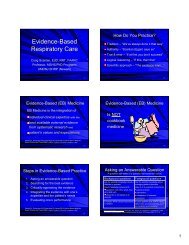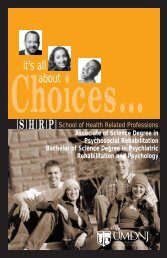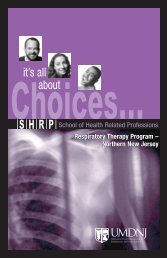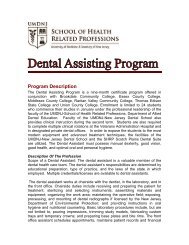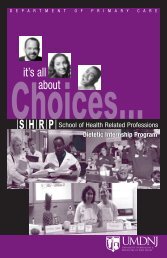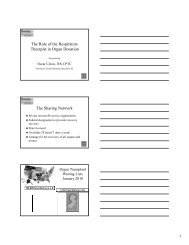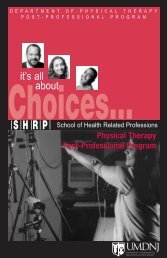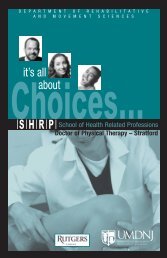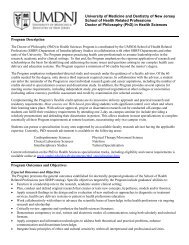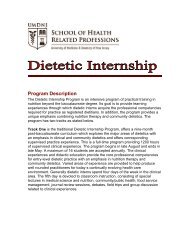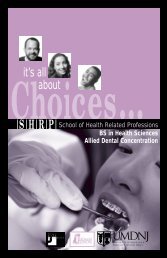Virtual reality-enhanced stroke rehabilitation ... - ResearchGate
Virtual reality-enhanced stroke rehabilitation ... - ResearchGate
Virtual reality-enhanced stroke rehabilitation ... - ResearchGate
You also want an ePaper? Increase the reach of your titles
YUMPU automatically turns print PDFs into web optimized ePapers that Google loves.
JACK et al.: VIRTUAL REALITY-ENHANCED STROKE REHABILITATION 317tionation, and strength. A novel performance-driven exerciseprogram was outlined, in which a patient’s own performancedictates future session targets.The VR rehab system was evaluated on three <strong>stroke</strong> patientsin an intensive therapy program. Typically, three or four sessionsof the four training exercises detailed here were run every day,five days a week, for a total of nine days followed, on the tenthday, by a reevaluation. Objective measurements revealed thateach patient showed improvement on most of the hand parametersover the course of the training. Independent dynamometermeasurements also showed significant grasp-force increases intwo of the three patients’ right hands. Two of the patients hadimprovements in their left (“good”) hands, as well. One patienthad no improvement in the left hand-grasping force, but didshow a 59% increase in right hand grasping force. Because theVR-based therapy was the only training that included a force exertionexercise, this result may be indicative of positive effects.The subjects showed improvement in functional activities ofdaily living, although is not possible, at this point, to distinguishthe contributions of the VR training and the real-world training.Further studies are planned to elucidate these distinctions andto quantify the overall clinical efficacy of VR-based therapy for<strong>stroke</strong> patients. VR <strong>rehabilitation</strong> may become an interestingand useful adjunct to traditional therapy by providing objectivequantification of the training process, as well as a motivatingway of using massed practice.A web interface to the Oracle database is being developed toprovide easy access for data retrieval and analysis. A left-handedRMII glove is under development to support patients with lefthandeddeficits. Also, other haptic devices for applying forcefeedback to the elbow and shoulder are under consideration.ACKNOWLEDGMENTThe authors wish to thank Dr. E. Taub at the University ofAlabama at Birmingham for his guidance in the implementationof CI therapy concepts into the non-VR tasks. A. Merians spenttwo weeks in Dr. Taub’s lab learning the CI techniques.REFERENCES[1] M. L. Aisen, H. I. Krebs, N. Hogan, F. McDowell, and B. T. Volpe,“The effect of robot-assisted therapy and rehabilitative training on motorrecovery following <strong>stroke</strong>,” Arch. Neurol., vol. 54, pp. 443–446, Apr.1997.[2] M. Ault, Oracle8i Administration and Management. New York: Wiley,2000.[3] G. Burdea and P. Coiffet, <strong>Virtual</strong> Reality Technology. New York:Wiley, 1994.[4] G. Burdea, V. Popescu, V. Hentz, and K. Colbert, “<strong>Virtual</strong> <strong>reality</strong>-basedorthopedic tele<strong>rehabilitation</strong>,” IEEE Trans. Rehab. Eng., vol. 8, pp.430–432, Sept. 2000.[5] M. Dam et al., “The effects of long-term <strong>rehabilitation</strong> therapy on post<strong>stroke</strong>hemiplegic patients,” Stroke, vol. 24, pp. 1186–1191, 1993.[6] P. W. Duncan, M. Propst, and S. G. Nelson, “Reliability of theFugl–Meyer assessment sensorimotor recovery following cerebrovascularaccident,” Phys. Therapy, vol. 63, no. 10, pp. 1606–1610, 1983.[7] P. Duncan, “Synthesis of intervention trials to improve motor recoveryfollowing <strong>stroke</strong>,” Stroke Rehab., vol. 3, no. 4, pp. 1–20, 1997.[8] Engineering Animation Inc. (2000) WorldToolKit. [Online]. Available:http://www.eai.com/products/sense8/worldtoolkit.html.[9] N. Foreman, P. Wilson, and D. Stanton, “VR and spatial awareness indisabled children,” Commun. ACM, vol. 40, no. 8, pp. 76–77, 1997.[10] M. Girone, G. Burdea, M. Bouzit, and J. Deutsch, “Orthopedic <strong>rehabilitation</strong>using the “Rutgers Ankle” interface,” in Proc. <strong>Virtual</strong> RealityMeets Medicine 2000: IOS Press, Jan. 2000, pp. 89–95.[11] D. Gomez, “A dextrous hand master with force feedback for virtual <strong>reality</strong>,”Ph.D. dissertation, Rutgers Univ., Piscataway, NJ, May 1997.[12] J. Deutsch, J. Latonio, G. Burdea, and R. Boian, “Rehabilitation of musculoskeletalinjury using the Rutgers ankle haptic interface: three casereports,” in Eurohaptics 2001, Birmingham, U.K., 2001.[13] D. Inma et al., “Teaching orthopedically impaired children to drive motorizedwheelchairs in virtual <strong>reality</strong>,” in Center Disabilities <strong>Virtual</strong> RealityConf., 1994.[14] D. Jack, R. Boian, A. Merians, S. Adamovich, M. Tremaine, M. Recce,G. Burdea, and H. Poizner, “A virtual <strong>reality</strong>-based exercise program for<strong>stroke</strong> <strong>rehabilitation</strong>,” in Proc. ASSETS 2000: 4th ACM SIGCAPH Conf.Assistive Technologies, Arlington, VA, 2000, pp. 56–63.[15] R. H. Jebsen, N. Taylor, R. B. Trieschman, M. J. Trotter, and L. A.Howard, “An objective and standardized test of hand function,” Arch.Phys. Med. Rehab., vol. 50, pp. 311–319, 1969.[16] W. Jenkins and M. Merzenich, “Reorganization of neocortical representationsafter brain injury: A neurophysiological model of the bases ofrecovery from <strong>stroke</strong>,” in Progress in Brain, F. Seil, E. Herbert, and B.Carlson, Eds. New York: Elsevier, 1987.[17] H. Jorgensen et al., “Outcome and time course of recovery in<strong>stroke</strong>—Parts I and II. The Copenhagen <strong>stroke</strong> study,” Arch. Phys. Med.Rehab., vol. 76, pp. 399–412, 1995.[18] Kopp, Kunkel, Muehlnickel, Villinger, Taub, and Flor, “Plasticity inthe motor system related to therapy-induced improvement of movementafter <strong>stroke</strong>,” Neuroreport, vol. 10, no. 4, pp. 807–810, Mar. 17, 1999.[19] J. Kozak et al., “Transfer of training from virtual <strong>reality</strong>,” Ergonomics,vol. 36, no. 7, pp. 777–784, 1993.[20] J. Kramer, P. Lindener, and W. George, “Communication system fordeaf, deaf-blind, or nonvocal individuals using an instrumented glove,”U.S. Patent 5 047 952, Sept. 10, 1991.[21] H. I. Krebs, N. Hogan, M. L. Aisen, and B. T. Volpe, “Robot-aided neuro<strong>rehabilitation</strong>,”IEEE Trans. Rehab. Eng., vol. 6, pp. 75–87, Mar. 1998.[22] K. G. Kwakkel et al., “Effects of intensity of <strong>rehabilitation</strong> after <strong>stroke</strong>,a research synthesis,” Stroke, vol. 28, no. 8, pp. 1550–1556, 1997.[23] P. Langhorne, R. C. Wagenaar, and C. Partridge, “Physiotherapy after<strong>stroke</strong>: More is better?,” Physiotherapy Res. Int., vol. 1, pp. 75–88, 1996.[24] J. W. Lee and K. Rim, “Maximum finger force prediction using a planarsimulation of the middle finger,” in Proc. Instrum. Mech. Eng., vol. 204,1990, pp. 160–178.[25] J. Liepert, W. H. Miltner, H. Bauder, M. Sommer, C. Dettmers, E. Taub,and C. Weiller, “Motor cortex plasticity during constraint-induced movementtherapy in <strong>stroke</strong> patients,” Neurosci. Lett., vol. 250, no. 1, pp. 5–8,1998.[26] J. Liepert, H. L. Bauder, W. Miltner, E. Taub, and C. Weiller, “Treatmentinducedcortical reorganization after <strong>stroke</strong> in humans,” Stroke, vol. 31,pp. 1210–1216, 2000.[27] A. Merians, D. Jack, R. Boian, M. Tremaine, G. Burdea, S. Adamovich,M. Recce, and H. Poizner, “<strong>Virtual</strong> <strong>reality</strong>-augmented <strong>rehabilitation</strong> forpatients post <strong>stroke</strong>: Three case studies,” Phys. Therapy, 2001, submittedfor publication.[28] National Stroke Association. (2000). [Online]. Available:http://www.<strong>stroke</strong>.org.[29] R. J. Nudo, “Neural substrates for the effects of rehabilitative trainingon motor recovery after ischemic infarction,” Science, vol. 272, pp.1791–1794, 1996.[30] V. Popescu, G. Burdea, M. Bouzit, M. Girone, and V. Hentz, “Orthopedictele<strong>rehabilitation</strong> with virtual force feedback,” IEEE Trans. Inform.Technol. Biomed., vol. 4, pp. 45–51, Mar. 2000.[31] P. Rijken and J. Dekker, “Clinical experience of <strong>rehabilitation</strong> therapistswith chronic diseases: A quantitative approach,” Clin. Rehab., vol. 12,no. 2, pp. 143–150, 1998.[32] P. Tangeman, D. Banaitis, and A. Williams, “Rehabilitation of chronic<strong>stroke</strong> patients: Changes in functional performance,” Arch. Phys. Med.Rehab., vol. 71, pp. 876–880, 1990.[33] E. Taub et al., “Technique to improve chronic motor deficit after <strong>stroke</strong>,”Arch. Phys. Med. Rehab., vol. 74, pp. 347–354, 1993.[34] E. Taub, J. E. Crago, L. D. Burgio, T. E. Groomes, E. W. Cook, 3rd,S. C. DeLuca, and N. E. Miller, “An operant approach to <strong>rehabilitation</strong>medicine: Overcoming learned nonuse by shaping,” J. Exp. Anal.Behav., vol. 61, no. 2, pp. 281–293, Mar 1994.[35] E. Taub and S. L. Wolf, “Constraint induced movement techniques tofacilitate upper extremity use in <strong>stroke</strong> patients,” Top. Stroke Rehab.,vol. 3, no. 4, pp. 38–61, 1997.



